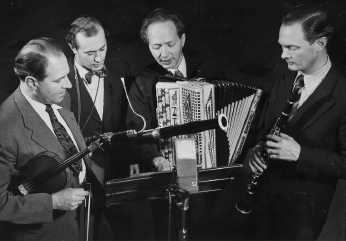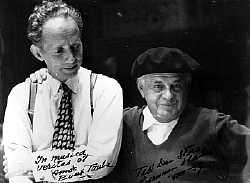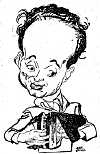|
Sheet music catalogue - strings - brass - choir - organ About Gunnar |
Gunnar was born in Stockholm. His father, Arvid Hahn, a master tailor, and his mother, Jenny, were both from Östergötland. His huge talent for music became evident in his early childhood; he started to play the accordion as a three-year old, and at age five, he was placed in charge of performing the dance music at his family's large gatherings. In 1930, after passing the organist examinations at the Stockholm Conservatory of Music, he chose a career as a concert pianist. Gunnar started performing with the Radio Orchestra and the Concert Society as early as 1927 and, in 1932, made his solo debut as a classical pianist. In addition, he developed his skill on accordion to the level of virtuoso, his playing style being greatly influenced by his mastery of classical music. Gunnar defied the conventions of musical classifications, when he expanded his repertoire to include Swedish folk music, so dear to him, and started to compose arrangements for folk ballads. In 1936, he founded a quartet of musicians, featuring violin, clarinet, accordion and bassoon. The quartet performed Gunnar's arrangements of folk ballads and often appeared on radio. Read Gunnar´s own words about the quartet.

The quartet of musicians including
Karl Nilheim, Bruno Lavér,
In addition, in order to further the cause of musicians and help improve their finances, he served as president of both the Society of Pianists (1938-39) and the Swedish Association of Soloists (1940) and founded (together with Yngve Flycht) the Society for the Promotion of Music (1940).
Gunnar's career as a concert pianist culminated in a tour in England and the U.S.A. in 1949 and 1950. Thereafter, he devoted his time to his growing interest in arranging folk music for orchestras, resulting in weekly radio programs that ran for extensive periods during much of 1957 through 1963, and he made numerous records, as well. His engagement with "Gunnar Hahn's Orchestra of Folk Dance" ensured a broad public following and he became well known. He furthermore collaborated with Evert Taube; they appeared together in at least 40 radio programs, some of which have been eternalized on a record. Gunnar also composed music for the use of various theatres, such as the Royal Theatre of Drama, The Park Theatre, The Radio Theatre and the Theatre of the City of Stockholm. His long lasting concern for musicians trying their luck as soloists got him engaged anew in their cause. An original promoter of Country Concerts, he became one of their producers in the late 1960's and eventually ended up as their composer and arranger.

Gunnar och Evert Taube 1957
Among Gunnar's renown compositions and arrangements are Götisk svit (Geatish Suite) for string band (1948); Svenska folkvisor (Swedish Folk Ballads) for soprano and piano (1959, reprinted in 1999); Gladelig sjunge vi (We Sing with Joy) - a Christmas cantata for solo voices, mixed choir and orchestra (1959); Rondo lapponico (Lappish Rondo) - a frequently performed choral piece made up of jojkar (traditional Lapp songs often extolling nature (1967); Svensk körsvit (Swedish Choral Suite) for mixed choir and orchestra (1968); Krig och fred i svensk folklore (War and Peace in Swedish Folklore) for ensemble of brass instruments (1972); Rosa Rosarum - a significant series of ballads for solo voice, piano and chorus to texts by Bo Setterlind (1978); and Tre flöjter (Three Flutes) for solo flute and string band (1986). There are more than 50 records with Gunnar Hahn's music, and among the CD's are: Svenska låtar på mitt sätt (Swedish Songs My Way) (2 CDs, 1997), Krig och fred i svensk folklore (War and Peace in Swedish Folklore) (1998) and Spelmanskvartetten Folia spelar Gunnar Hahn (The Quartet of Musicians, Folia, Plays Gunnar Hahn).
Author: Robert Hahn. Translation: Christina Graham. |


